Abstract
A model is described in which damage to a single intracellular locus can lead to a tumorigenic transformation. Assuming a large number of independent intracellular loci to be at risk and assuming that damage to a locus sufficient to cause a tumorigenic transformation occurs with probability greater than zero for all doses greater than zero, leads to the use of the Weibull distribution to characterize the probability of a nonspontaneous tumorigenic cellular transformation occurring after exposure to a given dose of carcinogen. The excess lifetime tumor incidence (i.e., the proportion of tumor bearers) above the spontaneous incidence is used as an estimate of the non-spontaneous incidence and is characterized by a tumor incidence function that represents the probability of occurrence of one or more non-spontaneous tumorigenic cellular transformations amongN(D) independent surviving cells per individual, after exposure to a doseD of carcinogen. The tumor incidence function is fitted to published data for the excess tumor incidence after exposure of animals or humans to ionizing radiation and after exposure of animals to chemical carcinogens.
Similar content being viewed by others
Literature
Bratcher, T. L. 1977. “Bayesian Analysis of a Dose-Response Experiment with Serial Sacrifices.”J. Envir. Pathol. Toxicol. 1, 287–292.
Brown, J. M. 1977. “The Shape of the Dose-Response Curve for Radiation Carcinogenesis, Extrapolation to Low Doses.”Radiat. Res. 71, 34–50.
Clapp, N. K., E. B. Darden and M. C. Jernigan. 1974. “Relative Effects of Whole-body Sublethal Doses of 60-MeV Protons and 300-kVp X-Rays on Disease Incidences in RF Mice.”Radiat. Res. 57, 158–186.
Guess, H., K. Crump and R. Peto. 1977. “Uncertainty Estimates for Low-Dose-Rate Extrapolations of Animal Carcinogenicity Data.”Cancer Res. 37, 3475–3483.
Gumbel, E. J. 1958.Statistics of Extremes. New York: Columbia University Press.
Hartley, H. O. and R. L. Sielken, Jr. 1977. “Estimation of ‘Safe Doses’ in Carcinogenic Experiments.”J. Envir. Pathol. Toxicol. 1, 241–278.
Kellerer, A. M. and H. H. Rossi. 1972. “The Theory of Dual Radiation Action.”Current Topics Radiat. Res. Q. 8, 85–158.
Koshnurnikova, N. A., V. K. Lemberg and E. R. Lyubchanskiy. 1971. “Remote After-effects of Inhalation of Soluble Plutonium-239 Compounds.” InOtdalennye Posledstviya Luchevykh Porazheniy (Remote After-effects of Radiation Damage), pp. 305–314 (AEC-tr-7387, pp. 334–343). Russian Atomizdat.
Maltoni, C. 1975. “The Value of Predictive Experimental Environmental Carcinogenesis—an Example: Vinyl Chloride.”Ambio 4, 18–23 (cited from Guesset al., 1977).
Mantel, N. and W. R. Bryan. 1961. “‘Safety’ Testing of Carcinogenic Agents.”J. Natn. Cancer Inst. 27, 455–470.
—, N. R. Bohidar, C. C. Brown, J. L. Ciminera and J. W. Tukey. 1975. “An Improved Mantel-Bryan Procedure for ‘Safety’ Testing of Carcinogens.”Cancer Res. 35, 865–872.
O'Gara, R. W., M. G. Kelly, J. Brown and N. Mantel. 1965. “Induction of Tumors in Mice Given a Minute Single Dose of Dibenz(a,h)anthracene or 3-Methylcholanthrene as Newborns. A Dose-Response Study.”J. Natn. Cancer Inst. 35, 1027–1039.
Pike, M. C. 1966. “A Method of Analysis of a Certain Class of Experiments in Carcinogenesis.”Biometrics 22, 142–161.
Rowland, R. E., A. F. Stehney and H. F. Lucas, Jr. 1978. “Dose-Response Relationships for Female Radium Dial Workers.”Radiat. Res. 76, 368–383.
Ryan, T. A., B. L. Joiner and B. F. Ryan. 1976.MINITAB Student Handbook, North Scituate, MA: Duxbury Press.
Sanders, C. L., G. E. Dagle, W. C. Cannon, D. K. Craig, G. J. Powers and D. M. Meier. 1976. “Inhalation Carcinogenesis of High-Fired239PuO2 in Rats.”Radiat. Res. 68, 349–360.
—,-—,-—, G. J. Powers and D. M. Meier. 1977. “Inhalation Carcinogenesis of High-Fired238PuO2 in Rats.”Radiat. Res. 71, 528–546.
Scott, B. R. 1977. “Mechanistic State Vector Model for Cell Killing by Ionizing Radiation.”Radiat. Environ. Biophys. 14, 195–211.
— 1980. “A Model for Early Death Caused by Radiation Pneumonitis and Pulmonary Fibrosis After Inhaling Insoluble Radioactive Particles.”Bull. Math. Biol. 42, 447–459.
Terracini, B., P. N. MaGee and J. M. Barnes. 1967. “Hepatic Pathology in Rats on Low Dietary Levels of Dimethylnitrosamine.”Br. J. Cancer 21, 559–565 (cited by Guesset al., 1977).
Upton, A. C., M. L. Randolph and J. W. Conklin. 1970. “Late Effects of Fast Neutrons and Gamma-Rays in Mice as Influenced by the Dose Rate of Irradiation: Induction of Neoplasia.”Radiat. Res. 41, 467–491.
Walker, A. I. T., E. Thorpe and D. E. Stevenson. 1973. “The Toxicology of Dieldrin (HEOD). I. Long-Term Oral Toxicity Studies in Mice.”Food Cosmet. Toxicol. 11, 415–432 (cited by Guesset al., 1977).
Author information
Authors and Affiliations
Rights and permissions
About this article
Cite this article
Scott, B.R. A dose-response model for estimating lifetime tumor risks when cell killing occurs. Bltn Mathcal Biology 43, 487–501 (1981). https://doi.org/10.1007/BF02459435
Received:
Revised:
Issue Date:
DOI: https://doi.org/10.1007/BF02459435




